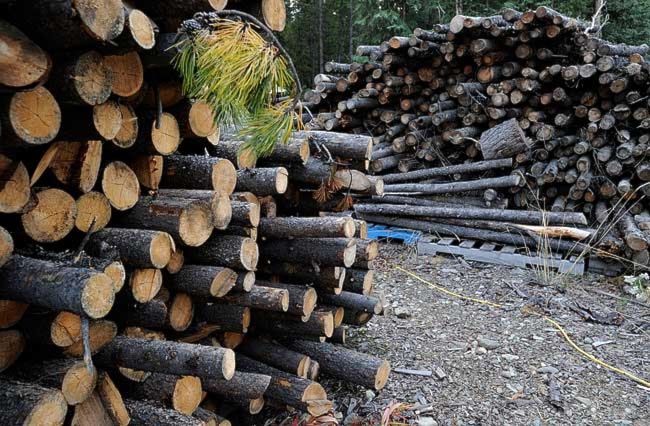Worried about Yukon’s looming electricity shortage? Ron Johnson has what he considers to be a win-win proposal.
The president of the Yukon Wood Products Association wants to see the territory push ahead with plans to build a wood-fed biomass plant.
He envisions a future in which the Yukon looks a lot like Sweden. There, biomass has been successfully used to heat and power cities the size of Whitehorse.
“We don’t need to be frightened about moving that way as a territory, because others have been there before,” said Johnson.
There’s no question whether the territory has enough trees to make this a reality. But it remains unclear whether Yukoners would be willing to stomach a dramatic increase in the amount of forest being cut.
Yukon Energy has proposed building a 25-megawatt biomass plant. That would cause the territory’s annual wood consumption to jump more than tenfold.
Currently, Yukoners cut approximately 10,000 cords of wood annually. A 25-megawatt plant would annually consume 112,000 cords.
Throw in more wood to be chewed into pellets to feed new residential stoves, and include the territory’s existing consumption, and Johnson reckons the territory could end up consuming a total of 125,000 cords annually.
That’s 200,000 cubic metres of timber - roughly 5,000 logging truck loads.
For Yukoners already queasy about the amount of wood felled near Haines Junction, this may not be a popular plan.
Cutting this much more wood requires more access roads. And, as the heated debate over the fate of the Peel Watershed proved, opening up the wilderness is always a touchy issue.
But that needs to be weighed against the upsides of biomass. To start, it’s a renewable resource - and, unlike wind or solar, it doesn’t depend on the weather behaving.
There’s dispute among scientists as to whether biomass is truly carbon neutral, as its boosters claim. But it certainly looks a lot cleaner than trucking up dirty diesel to burn.
And, if Johnson is right, biomass could help create more well-paying jobs for Yukoners, by helping the local wood industry grow.
Only one-fifth of the trees near Haines Junction are suitable for sale as timber, said Johnson. The rest is too scrawny or misshapen to use, so they end up being torched as waste.
If this waste wood could be sold as biofuel, and mills could move more volume, woodcutters could move into churning out higher-end products like log homes and glue-laminate beams.
“We’re not just talking about going out in the forest on ATVs, knocking down trees,” said Johnson. “We’re talking about a secondary industry too, at a Yukon scale.”
Take David Loeks. He runs a log-cabin building business in British Columbia. “I couldn’t operate that business here,” he said. “We wouldn’t have enough logs.”
A biomass plant could either be fed wood chips or pellets. Pellets have the advantage of also being fodder for automatically fed residential furnaces that have become big in European countries like Sweden, but have yet to become popular in North America.
The Champagne and Aishihik First Nations’ business arm, Dakwakada Development Corporation, is considering getting into the pellet business.
In April, Dakwakada signed a deal with Yukon Energy that sets out the terms of a potential partnership.
It has also signed a memorandum of understanding with the Village of Haines Junction, to assess the potential of building a biomass plant for electrical generation and a district heating system. The plant would generate three to five megawatts.
Starting small would suit local woodcutters fine. If a big biomass plant were quickly built, “we’d see a contract going to an Outside operator,” said Johnson. “Little benefit would accumulate in the territory, other than the electricity.”
Dakwakada hopes to eventually persuade Yukoners to switch over to residential pellet stoves. They’re relatively clean-burning, which means there’s little concern about smoke being caught in thermal inversions in neighbourhoods where this has been a problem, like Riverdale.
But for any of this to happen, the territory must make more wood available to cut. And it would need to issue longer-term timber licences.
To finance a biomass plant or pellet mill, its builders would need a guaranteed 20-year supply of wood. That’s currently not available, under the regulations. As it stands, mills are only able to obtain three-year supplies of wood, said Johnson.
There’s also currently a lot of slack in Yukon’s allowed wood cut, said Johnson.
The forests surrounding Teslin are considered capable of a sustained yield of 150,000 cubic metres annually. But the allowable cut, set about five years ago, is just 25,000 cubic metres.
The wood products association has approximately a dozen members. Perhaps 100 Yukoners are employed in the wood business, said Johnson.
“The cynical answer would be a whole whack in government, and not many out in the field. We’d like to reverse that.”
The Yukon Wood Products Association meets in Haines Junction’s community centre this Saturday, November 26, from 9 a.m. to 4:30 p.m. Officials with the government’s forest management branch will be there to discuss timber licence allocations and how to improve the regulatory system.
And Yukon Energy is holding a public meeting on plans to use wood biofuel to produce electricity. It’s on Thursday, December 1, from 7 p.m. to 9 p.m. at the Old Fire Hall.
Contact John Thompson at
johnt@yukon-news.com.
